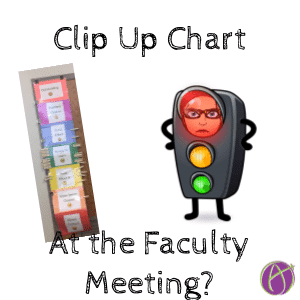
A tweet by Jon LeFevre indicated that a clip up chart was put up in a faculty meeting. Turns out, no surprise, the adults didn’t like it. So why are we doing this to kids?
We utilized a clip chart with ADULTS during our training this morning. Turns out that adults absolutely hate this public display of behavior. Resulted in anxiety, disengagement, fear, resentment and embarrassment. If adults don’t like these tools, how do you think kids feel? pic.twitter.com/fG5Q4QIxH1
— Jon LeFevre (@JonLeFevreSISD) February 21, 2019
On multiple occasions when I have picked up my kids from school they report to me who in class clipped down. While I tell them that is not something to report, how is it that they know that information in the first place?
I have multiple times talked with a parent telling me a story of how their good child was devastated over clipping down. Their mistake, whatever it was, was publicly published for every kid in the class to see. Their kid’s day was ruined and it was what they obsessed over for at least the entire day.
While you may work harder to make it to the faculty meeting on time if the principal was going to publicly clip you down, is that a place you want to work?
Do the ends justify the means? While well intentioned, clip up charts can have a devastating effect on a students self perception. A kid who usually clips up is devastated over one clip down. They let other kids in the class know who the bad kids are. Labeling kids is not a good thing.










2 thoughts on “Clip Up Chart in the Faculty Meeting”
My son goes to school in the district for which I teach. Last year in Kindergarten was his first experience with behavior charts like this. He is almost always a decent kid and does very well in school. But there were times when had to move his clip in front of the whole class. Sometimes it was because he did something that was genuinely bad. Other times, it seemed to be over some very insignificant behavior offences, like talking in the bathroom. Seriously. But because the result of talking in the bathroom was no different than it was for more serious errors in judgment, every time he had to move his clip for something that I personally thought was ridiculous, the lesson he learned about himself was that he was a bad kid, which he isn’t. But that’s what he learned about himself. I get that teachers want to incentivize their students to be well-behaved. But as professional educators, we must be capable of putting in more critical thought to our solutions so that we can avoid the pitfalls of these easy sounding solutions that may do more harm than good.
Having students write their name on the board or move their clip up/down on the behavior chart were things I did as a brand-new teacher, back before I had figured out relationship-building yields much better results in the behavior-management department. It was almost always (for me) a way to assert my authority. #weirdflex I didn’t know back then what I knew after a few years teaching challenging students: a kid’s behavior was reflective of many things, including their state of crisis, their level of hunger/tiredness, or their lack of engagement in the activity we were involved in. I can’t imagine shaming my tired kid who got up at 4:30 to feed, water, muck out horse pens before school simply because she was not patient with her giggling, less-than-serious classmates who kept talking around her while she was trying to concentrate on math problems through the exhaustion her little 7th grade body was fighting. These charts and tactics are indications of poor classroom management, although we’re taught by our mentors, administrators and professors that employing them exhibits “good structure and clear expectations”. I am glad there’s someone out there challenging adults to treat their students like humans, the same way we adults would like to be treated.